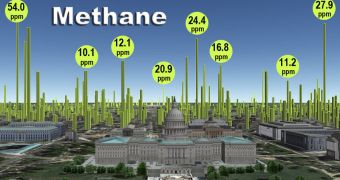Though very young when compared to a European city, the capital of the United States, Washington DC, remains one of the oldest cities in the country. Created in the latter half of the 18th century, much of the metropolis' infrastructure is beginning to decay, including its underground pipeline system.
According to researchers at the Duke University, gas pipelines in the city are a real problem, since they appear to be deteriorating at a rapid pace. During a recent study the team conducted, more than 6,000 methane leaks were discovered around the city, each of different magnitude.
Scientists drove for a total of 4,023 kilometers (1,500 miles) in the city for this study. They carried with them a few scientific measuring instruments, capable of picking up and cataloging even minor variations in atmospheric methane concentrations.
Duke University ecologist and environmental scientist Robert Jackson, a member of the study team, said that the instruments were able to discover an average of four leaks per every mile (1.6 kilometers).
This level of decay is higher than the one recorded in 2011 in Boston, where researchers applied the same method to study the average decay of underground pipelines. The new study reveals that the methane emissions present in Washington DC are nearly two times higher than the national average.
Scientists were able to confirm that the gas came from pipelines through the fact that it was accompanied by compounds such as ethane and propane, which do not naturally form alongside methane in nature. When bacteria, livestock or decaying plants produce methane, the chemical is pure, NPR reports.
Researchers also discovered a total of 12 emission spots where methane concentrations were high enough to be potentially explosive. “The really surprising thing [is that] when we went back four months later after calling in these leaks, nine of the 12 hadn't been fixed. And that really shocked me,” Jackson said.
Details of the research effort were published in this week's issue of the esteemed journal Environmental Science and technology. The Duke investigators report that significant variations occur in methane concentrations across the city, with areas such as the National Mall remaining largely methane-free.

 14 DAY TRIAL //
14 DAY TRIAL //